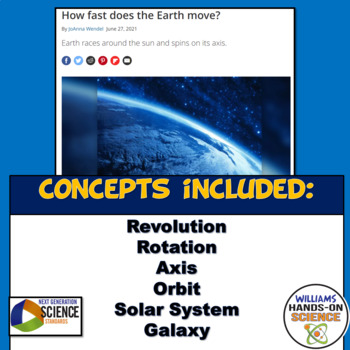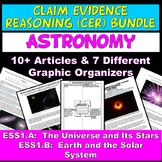CER Solar System Claim Evidence Reasoning MS-ESS1-1 MS-ESS1-2 Digital
- Zip
- Google Apps™

What educators are saying
Also included in
- Students learn about various current events and discoveries in Astronomy through a C.E.R. (Claim Evidence Reasoning) graphic organizer. This is great for getting your students to explain phenomena in a meaningful way and it allows you as the instructor to adequately assess their understanding of conPrice $34.00Original Price $66.50Save $32.50
Description
Students learn how fast the earth travels around the sun through a C.E.R. (Claim Evidence Reasoning) graphic organizer. This is great for getting your students to explain phenomena in a meaningful way and it allows you as the instructor to adequately assess their understanding of concepts. The students figure out what the "Claim" is in the article, they then use data that supports the claim in the "Evidence" section, draw visual evidence and then explain why the evidence supports the claim in the "Reasoning" section.
The article has the following concepts:
Revolution
Rotation
Axis
Orbit
Solar System
Galaxy
Take a look at my CER Mega bundle!
What you get with this resource:
-2 graphic organizer PDF's
-2 Google Ready graphic organizers
-Anchor chart to scaffold and support students with CER
-Article Link in Google Slideshow
-Google Classroom Tutorial
Related Products:
Solar System NGSS Claim Evidence Reasoning Mysterious Planet Nine Google Ready
Gravity & Solar System NGSS ESS1.A ESS1.B Online Simulation Google Ready
Gravity & Mass NGSS: MS-PS2-2 MS-PS2-4 5e Planning & Carrying Out Investigation
This is great for a current event, sub plan, homework, critical thinking, scaffolding and/or reinforcement of concepts!
You get a CER graphic organizer, an editable key, the article, tips for CER and the link to the website in the article.
NGSS for Middle School:
ESS1.A: The Universe and Its Stars
•Patterns of the apparent motion of the sun, the moon, and stars in the sky can be observed, described, predicted, and explained with models. (MS-ESS1-1)
ESS1.B: Earth and the Solar System
•The solar system consists of the sun and a collection of objects, including planets, their moons, and asteroids that are held in orbit around the sun by its gravitational pull on them. (MS-ESS1-2), (MS-ESS1-3)
•This model of the solar system can explain eclipses of the sun and the moon. Earth’s spin axis is fixed in direction over the short-term but tilted relative to its orbit around the sun. The seasons are a result of that tilt and are caused by the differential intensity of sunlight on different areas of Earth across the year. (MS-ESS1-1)
NGSS Science and Engineering Practices:
SEP's Asking Questions and Defining Problem:
Students at any grade level should be able to ask questions of each other about the texts they read, the features of the phenomena they observe, and the conclusions they draw from their models or scientific investigations.
Engaging in Argument from Evidence:
In 9–12 builds on K–8 experiences and progresses to using appropriate and sufficient evidence and scientific reasoning to defend and critique claims and explanations about the natural and designed world(s). Arguments may also come from current scientific or historical episodes in science.
CCC's: Patterns
Observed patterns of forms and events guide organization and classification, and they prompt questions about relationships and the factors that influence them.
TERMS OF USE
• All rights reserved by Williams Hands On Science, Inc.
• This product is to be used by the original purchaser only.
• Intended for classroom and personal use only.
• Copying for more than one teacher, classroom, department, school, or school system is prohibited.
• This product may not be distributed or displayed digitally for public view.
• Failure to comply is a copyright infringement and a violation of the Digital Millennium Copyright Act (DMCA).
If there are any errors or questions, please contact me through TpT or email me at:
williamshandsonscience@gmail.com
Thank you for taking a look!
Please follow me on TpT for new products and check me out on Instagram for my products in action!






